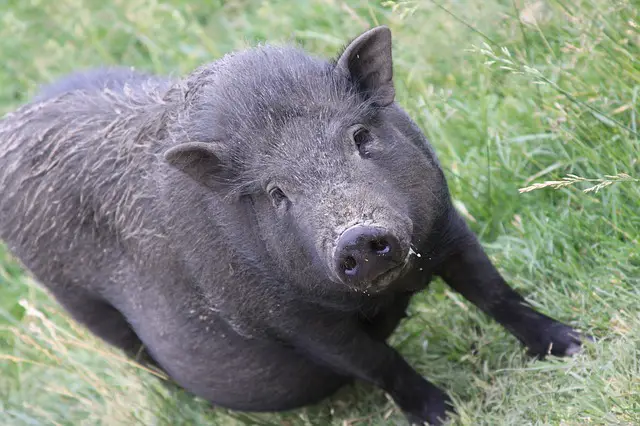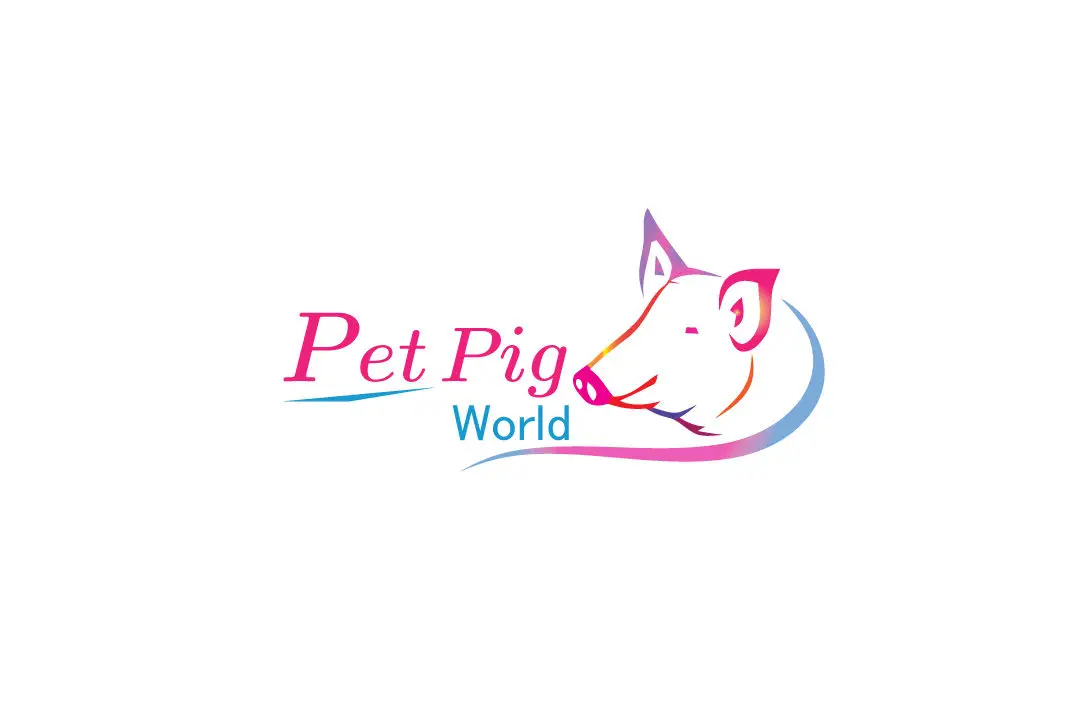You’ve probably heard about the popular breed of small pigs called the “Pot Bellied pigs” and now you are curious if they can really stay small as they are expected to be.
How big do pot bellied pigs get? The average weight for a matured pot bellied pig is about 50 kilos (110 pounds) while females are about 48 kilos (106 pounds) and the height for an average male pot bellied pig can grow up to 14 inches (36 cm) and a female can grow about 13 inches (35 cm) according to breeders.
However, in order to give you a realistic answer to properly set your expectations… pigs have a diverse genetics and even when they do come from a naturally small breed, there is NO absolute guarantee that they will stay as small as expected.

There is really no way to accurately predict a pig’s height and weight because they often grow larger than expected while some stay surprisingly small.
For potential owners, we want to properly address the “miniature pig” trend and directly state that mini pigs are not considered as an actual breed by science because they are products of genetic manipulation.
Genetic manipulation is considered “selective breeding” in simpler terms which means different breeds are carefully chosen and paired together in order to produce a completely unique offspring.
Before you get a pot bellied pig which is considered a “miniature pig“, we want you to keep in mind that they might grow larger as they continue to age.
Most of the time, the pot bellied pigs are often used for crossbreeding and might produce an offspring that will not follow the breed’s standard sizes. There also several factors that can contribute in affecting a pig’s growth.
Besides, regardless of the size, pigs including pot bellied pigs have BIG personalities and that is the best part of owning and raising a pig.
What are the factors that affect a pot-bellied pig’s growth
There are only a few things that affect a pig’s growth and we must keep in mind that some of these things are truly beyond our control.
- Original genetics
- Diet or Food consumption
- Environment
- Health
- Manipulated genetics
Original genetics
This is about the true genes related to a pig that can go all the way back to their ancestors.
For some rare cases, an example is a now black breed of pig used to be red in the past but managed to produce a completely red offspring without being crossbred.
There are breeds that have stronger genetics than the other which can impact a pig’s size or growth.
Diet or Food consumption
There are breeders who either overfeed or underfeed a pig in order to control their growth or the offspring’s possible size.
This method is discouraged if it can be cruel to the animal and may also result in several health complications to both the pig and offspring.
For natural instances, a pig following their normal diet and consuming their natural source of food will possibly stay close to their breed’s standard sizes.
Environment
There are rare times when certain breeds tend to intentionally hold back their growth using methods that may or may not be familiar to our studies.
Depending on their environment, animals will adjust to fulfill nature’s demands and for the sake of survivability.
This element is still a bit unclear for us and continues to be observed and studied by our researchers or scientists.
Health
This might depend on the parents or how the offspring will be raised. If the parents are healthy the higher chance of having a healthy piglet that will have the average / standard size of the breed.
Diseases or physical injuries can stunt the growth of pigs and even permanently halt their growth which can be carried by their offspring.
Health plays a big part in growing.
Manipulated genetics
The opposite of the first element which is “original genetics” is manipulated genetics. This is about selective breeding and can either turn out great, normal or just plain bad.
Selective breeding is not always popular in all places as it can potentially be harmful to the participating animals as there are also cases of abusive breeders.
This is not the same for all and there are still reputable breeders out there that is why we advise buyers to be careful and look for a trustworthy deal.
How selective breeding can affect a Pot-bellied pig’s growth
Selective breeding is somewhat no different from “Genetic manipulation”. It is the process of carefully pairing up specific breeds with each other in hopes of producing a better, stronger and desired breed as a result.
There are advantages and disadvantages for selective breeding. If you have heard of teacup puppies or munchkin cats, they are also products of selective breeding.
Those “breeds” or the “results” of selective breeding are said to be often born with medical complications, deformed body parts, weaker bone structures, disabilities or other sicknesses.
Pigs are not exempted from this and can also suffer from the negative sides of selective breeding.
Many people are against selective breeding but despite that, there are some breeders that claim their procedures are different from others and that it is safe and healthy for the animal.
Negative cases of selective breeding are underfeeding the animals and force pairing the two animals.
This section is very important to shed some light on those who are not aware of the process of selective breeding and what it can possibly do to animals.
The advantage is the possibility of creating a stronger breed by combining two different breeds. Other than that, there are more possible disadvantages rather than advantages as of the moment.
What is a Pot Bellied Pig?
There are different strains connected to the Pot Bellied pigs but the most prominent one (and possibly the original) is the Vietnamese Pot Bellied pigs.
As the name implies, the breed originated from Vietnam and is indeed a naturally small breed of pigs that have a fat hanging belly where they got the name “Pot Belly” from.
The Vietnamese Pot Bellied pigs are currently considered endangered and is being supported to recover from a threatened level of population.
According to research, an average “purebred” Potbelly could grow 13 to 26 inches for height and 60 to 175 pounds in weight.
The traditional name for the Vietnamese Potbelly pigs is “Lon I” or “I” pig.
Over the years, the “Lon I” pigs were used to develop the “miniature” breed which is now popularly known as the Vietnamese Potbellied Pigs.
This is why it is believed that the term “miniature pig”, “teacup pig” and “micro pig” started with the Pot bellied pigs which is why when a person says “mini pigs” they are technically referring to the Vietnamese Pot Bellied pig.
However, as time flew by, other breeds of smaller pigs came into the scene either by discovery or by selective breeding and the entire “miniature pig” name became a specific “breed”.
If you’re looking for a more detailed answer about the Vietnamese Pot bellied pigs, you can check our article dedicated to them here.
What are the other breeds of pigs similar to Pot-bellied pigs in size?
As previously mentioned, there are other breeds of small pigs aside from the Vietnamese Pot bellied pigs. Though they are different breeds, we still want to set the same expectation that we wrote firsthand.
Below are the two most common breeds of small pet pigs.
Kunekune Pig
An average Kunekune can grow up to 24 inches tall. Kunekunes have very short legs paired with short and round body and may have two wattles until its chin.
This breed is believed to have originated from an Asian domestic breed. The local Maori people of New Zealand adopted the Kunekune which means “fat and round”
Juliana Pig
An average Juliana pig can grow up to 15-17 inches in height. The Juliana breed of pigs is said to originate from Europe through selective breeding just like most miniature pigs.
This breed is also known as the “miniature painted pig” because of its colorful, spotted appearance. This is part of their charm and makes them stand out from other pet pigs.
What is the smallest pig in the world?
The Pygmy hog is the smallest known breed of pig but it is a wild pig and not suitable for domestication. It is also critically endangered as of today and requires utmost protection from any possible harm.
Pygmy hogs used to inhabit the areas of India, Bhutan and Nepal but now that they are endangered, they can only be found in India.
They are about 55 cm to 71 cm (21.5 inches to 28 inches) long and can stand at 20 cm to 30 cm (8 inches to 12 in).
Their tail length is 2.5 cm (0.98 inches).
They weigh between 6.6 kg to 11.8 kg (15 lb to 26 lb).
A pygmy hog’s skin color is dark brownish black and the hair is also dark. Their piglets are born grayish-pink that eventually turns brown with yellow stripes along the body length.
Their heads are sharply tapered and they also have a slight crest of hair on their foreheads and on the back of their necks.
Adult male pygmy hogs have upper canines visible on the sides of their mouths.
The average lifespan of a Pygmy hog is 4 to 8 years and become sexually mature at around one to two years old.
Related Questions
- How much is a Pot bellied Pig?
The minimum amount starts at $300 up to $600 depending on the age and gender and sometimes, on your location or your breeders too.
Currently, the Vietnamese potbelly pig is treated as a rare breed and extremely threatened animal which is why getting your hands on one may be expensive or difficult.
A friendly reminder: Always seek a reputable breeder for a safe and secured transaction.
- What is the largest breed of pig in the world?
The largest known breed of pig is the Giant Forest Hog.
If you are familiar with Pumbaa of the popular Disney film, “The Lion King“, the warthog and Giant Forest Hog are similar in terms of appearance.
The Giant Forest Hog inhabits areas around Africa and some places in the West. They are wild pigs and may tend to be aggressive towards intruders.
It is best not to threaten or intimidate a Giant Forest Hog as they are capable of mauling a human with their tusks and leaving grave injuries.
Despite their large size, they are still considered prey animals and still in hunted by predators in the wild. They may not live as long as a domestic pig due to their mortality rate in the wild.
- What is the heaviest pig in the world?
The heaviest pig ever recorded for the Guinness World Book of Records was a pig named Big Bill. It was a Poland China breed of pig that weighed 1,157 kg (2,552 lb) in year 1993.
Pigs have a diverse genetics and may not stick to their expected size their breeds often grow into. The smallest breeds can grow larger while the large ones can be small.
